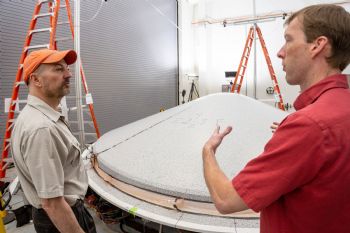
Protecting against the extremes of space travel is critical to the success of any mission. Lockheed Martin has designed built and validated the physical integrity of the heat shield that will protect NASA Jet Propulsion Laboratory’s
Mars 2020 rover from the heat and friction of its entry into the Martian atmosphere.
This mission will involve one of the most challenging entry, descent and landings ever attempted on the Red Planet. The heat shield’s aerodynamics serve as a ‘brake’ to slow the spacecraft from about 12,000mph, so the structure needs to be ‘flawless’.
The heat shield is half of a large aeroshell that will encapsulate the rover.
This is the tenth aeroshell system that Lockheed Martin has produced for NASA; and at 15ft in diameter, it is also one of the largest.
A static test was used to mimic the load that the heat shield will experience during the most extreme part of its journey — the entry phase.
Engineers used vacuum pumps to simulate a pressure of about 140,000lb on the structure — some 120% of the expected flight load.
Historically, this test uses conventional strain gauges and extensometers to monitor the ‘structural response’ at distinct points, but by partnering with NASA Langley Research Center, the engineers also used a new tool called photogrammetry (or digital image correlation).
This allowed them to monitor ‘full-field’ strains and displacements over the entire visible area of the structure in real time.
Sotiris Kellas, NASA Langley aerospace engineer (and lead for the technical demonstration), said: “While we have used this full-field photogrammetry technique on test articles in the past, this is the first successful implementation on official flight hardware.
“This technology will allow us to safeguard hardware during testing and, more importantly, provide data for test analysis correlation and improvement of our design and analysis tools.”